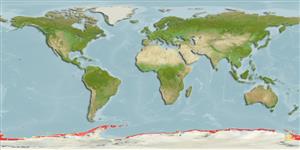Environment: milieu / climate zone / intervalo de profundidade / distribution range
Ecologia
marinhas batidemersal; intervalo de profundidade 430 - 1120 m. Deep-water; 60°S - 78°S
Southern Ocean: east Antarctica (Davis Sea, Ross Sea, Weddell Sea), South Shetland Islands and South Orkney Islands.
Tamanho / Peso / Idade
Maturidade: Lm ? range ? - ? cm
Max length : 21.0 cm TL macho/indeterminado; (Ref. 5181)
Feeds on isopods, gammaridean amphipods, octopods, polychaetes and mysids.
Life cycle and mating behavior
Maturidade | Reprodução | Desova | Ovos | Fecundidade | Larvas
Eakin, R.R., 1990. Artedidraconidae. p. 332-356. In O. Gon and P.C. Heemstra (eds.) Fishes of the Southern Ocean. J.L.B. Smith Institute of Ichthyology, Grahamstown, South Africa. (Ref. 5181)
Categoria na Lista Vermelha da IUCN (Ref. 130435: Version 2025-1)
Ameaça para o homem
Harmless
Utilização humana
Pescarias: sem interesse
Ferramentas
Relatórios especiais
Descarregue XML
Fontes da internet
Estimates based on models
Preferred temperature (Ref.
123201): -1.6 - 1, mean 0.3 °C (based on 415 cells).
Phylogenetic diversity index (Ref.
82804): PD
50 = 0.5000 [Uniqueness, from 0.5 = low to 2.0 = high].
Bayesian length-weight: a=0.00661 (0.00381 - 0.01146), b=3.16 (3.00 - 3.32), in cm total length, based on LWR estimates for this species & (Sub)family-body (Ref.
93245).
Nível Trófico (Ref.
69278): 3.3 ±0.46 se; based on food items.
Fishing Vulnerability (Ref.
59153): Low vulnerability (11 of 100).
🛈
Climate Vulnerability (Ref.
125649): Moderate to high vulnerability (50 of 100).
🛈
Nutrients (Ref.
124155): Calcium = 49.4 [27.7, 114.8] mg/100g; Iron = 0.545 [0.232, 1.117] mg/100g; Protein = 17.1 [16.0, 18.1] %; Omega3 = 0.287 [0.138, 0.585] g/100g; Selenium = 22.2 [8.2, 52.4] μg/100g; VitaminA = 11.8 [2.4, 54.0] μg/100g; Zinc = 0.613 [0.398, 0.953] mg/100g (wet weight);
